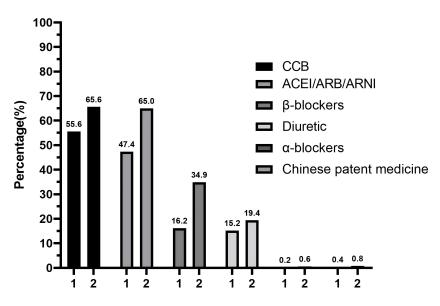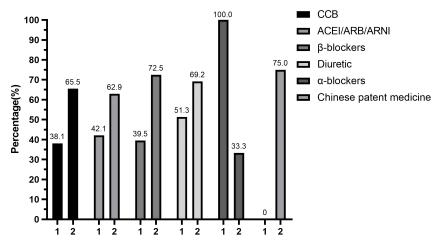Final ID: P3081
Evaluation of Blood Pressure Management Practices Among Non-Cardiovascular Physicians in Zhejiang Province, China
Abstract Body: Introduction: In clinical practice, we observed suboptimal blood pressure (BP) control prior to admission. Due to the need for treatment of other conditions, many patients are managed by non-cardiovascular specialists, resulting in discrepancies in BP control levels during hospitalization between specialist and non-specialist care.
Hypothesis: By reviewing clinical data, we analyzed BP management before and after treatment by cardiovascular specialists versus non-specialists, validating the hypothesis that non-specialist physicians demonstrate inadequate BP management during hospitalization.
Methods: We employed simple random sampling to select 500 adults with essential hypertension (EH) admitted to Zhejiang Provincial People's Hospital in January 2022. Clinical records were collected; comparisons were made regarding antihypertensive medication usage and BP control status before and after admission, along with an evaluation of management practices by non-specialist physicians.
Results: A total of 500 adults with EH participated in this study. Compared to pre-admission BP control, there was a significant increase in treatment rates, BP control, and combination therapy following admission (100.0% vs 83.0%, 67.0% vs 36.2%, 63.5% vs 40.6%, P<0.05). Approximately 62.4% of patients were admitted under non-specialty care, with only 37.5% achieving adequate BP control at admission time. The discharge BP control rate (63.0 % vs 72.9%), long-term monitoring adherence and discharge monitoring rates (81.1% vs 100.0%, 90.1% vs 100.0%), medication adjustment rate (20.2% vs 72.9%), and combined treatment rate (49.8% vs 84.0%) were all significantly lower than those seen in specialty care settings (all P<0 .05).
Conclusions: The treatment rate and control rate of patients prior to admission in Zhejiang Province were higher than those in other regions of China. However, over 60% of patients had inadequate BP control and require referral to hospitals with cardiovascular departments for further management. The core principles governing medication use before and after admission remained consistent, suggesting that differences in BP control may be linked to the use of combination medications. Over 60% of patients received care from non-cardiovascular departments, where rates of BP control, monitoring adherence, and medication adjustment were notably low—indicating a persistent gap in hypertension management knowledge among non-cardiovascular physicians.
Hypothesis: By reviewing clinical data, we analyzed BP management before and after treatment by cardiovascular specialists versus non-specialists, validating the hypothesis that non-specialist physicians demonstrate inadequate BP management during hospitalization.
Methods: We employed simple random sampling to select 500 adults with essential hypertension (EH) admitted to Zhejiang Provincial People's Hospital in January 2022. Clinical records were collected; comparisons were made regarding antihypertensive medication usage and BP control status before and after admission, along with an evaluation of management practices by non-specialist physicians.
Results: A total of 500 adults with EH participated in this study. Compared to pre-admission BP control, there was a significant increase in treatment rates, BP control, and combination therapy following admission (100.0% vs 83.0%, 67.0% vs 36.2%, 63.5% vs 40.6%, P<0.05). Approximately 62.4% of patients were admitted under non-specialty care, with only 37.5% achieving adequate BP control at admission time. The discharge BP control rate (63.0 % vs 72.9%), long-term monitoring adherence and discharge monitoring rates (81.1% vs 100.0%, 90.1% vs 100.0%), medication adjustment rate (20.2% vs 72.9%), and combined treatment rate (49.8% vs 84.0%) were all significantly lower than those seen in specialty care settings (all P<0 .05).
Conclusions: The treatment rate and control rate of patients prior to admission in Zhejiang Province were higher than those in other regions of China. However, over 60% of patients had inadequate BP control and require referral to hospitals with cardiovascular departments for further management. The core principles governing medication use before and after admission remained consistent, suggesting that differences in BP control may be linked to the use of combination medications. Over 60% of patients received care from non-cardiovascular departments, where rates of BP control, monitoring adherence, and medication adjustment were notably low—indicating a persistent gap in hypertension management knowledge among non-cardiovascular physicians.
More abstracts on this topic:
A Real-world Evaluation of Longitudinal Healthcare Expenses in a Health System Registry of Type-2 Diabetes Mellitus and Cardiovascular Disease Enabled by the 21st Century Cures Act
Dhingra Lovedeep, Aminorroaya Arya, Pedroso Aline, Rajpura Jigar, Mehanna Sherif, Tonnu-mihara Ivy, Khera Rohan
Acute Myocardial Infarction and Stroke Outcomes Vary Substantially Across Private Equity FirmsBartlett Victoria, Johnson Daniel, Liu Michael, Zheng Zhaonian, Wadhera Rishi


